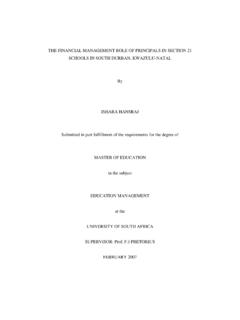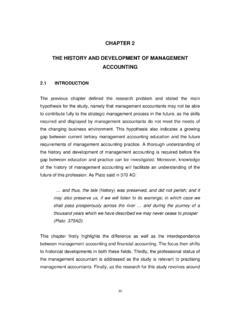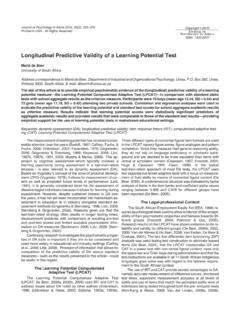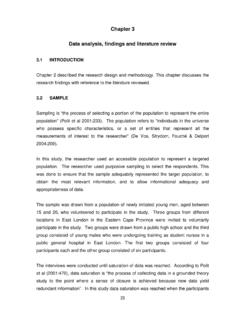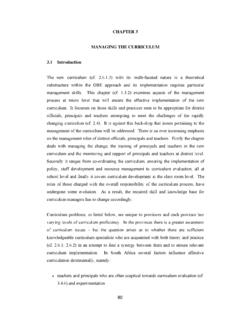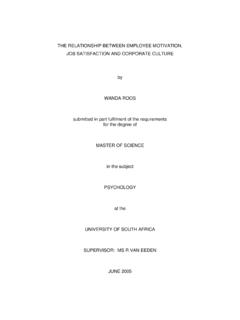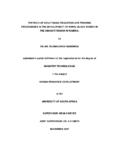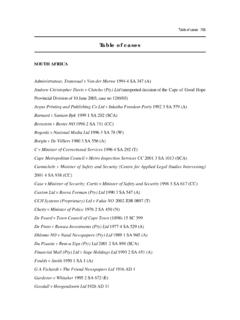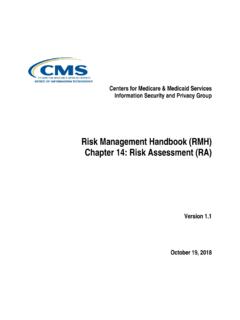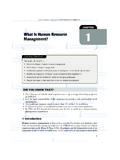Transcription of CHAPTER 3 ORGANISATIONAL COMMITMENT
1 37. CHAPTER 3 ORGANISATIONAL COMMITMENT . The main focus of this CHAPTER is to explore the concept ORGANISATIONAL COMMITMENT . The discussion includes the following aspects: theoretical background; definition of the concept ; adopted model for this study, dimensions of ORGANISATIONAL COMMITMENT ; development of ORGANISATIONAL COMMITMENT ; factors affecting the employees' COMMITMENT ; the effects of COMMITMENT ; and the management of ORGANISATIONAL COMMITMENT . THEORETICAL BACKGROUND OF THE concept . ORGANISATIONAL COMMITMENT . The concept ORGANISATIONAL COMMITMENT has grown in popularity in the literature on industrial and ORGANISATIONAL psychology (Cohen, 2003). Early studies on ORGANISATIONAL COMMITMENT viewed the concept as a single dimension, based on an attitudinal perspective, embracing identification, involvement and loyalty (Porter, Steers, Mowday & Boulian, 1974).
2 According to Porter et al (1974) an attitudinal perspective refers to the psychological attachment or affective COMMITMENT formed by an employee in relation to his identification and involvement with the respective organisation. Porter et al (1974, p 604) further describes ORGANISATIONAL COMMITMENT as an attachment to the organisation, characterised by an intention to remain in it;. an identification with the values and goals of the organisation; and a willingness to exert extra effort on its behalf . Individuals consider the extent to which their own values and goals relate to that of the organisation as part of ORGANISATIONAL COMMITMENT , therefore it is considered to be the linkage between the individual employee and the organisation. Another perspective on ORGANISATIONAL COMMITMENT is the exchanged-based definition or "side-bet" theory (Becker, 1960; Alluto, Hrebiniak & Alonso, 1973).
3 This theory holds that individuals are committed to the organisation as far as they hold their positions, irrespective of the stressful conditions they 38. experience. However, should they be given alternative benefits, they will be willing to leave the organisation. Mowday, Porter and Steers (1982, p 26) support the side-bet theory by describing ORGANISATIONAL COMMITMENT as a behaviour "relating to the process by which individuals become locked into a certain organisation and how they deal with this problem". This behavioural aspect of ORGANISATIONAL COMMITMENT is explained through calculative and normative commitments. The calculative or normative perspective refers to an employee's COMMITMENT to continue working for the organisation based on the notion of weighing cost- benefits of leaving an organisation (Hrebiniak & Alutto, 1972).
4 Wiener and Vardi (1980, p 90) describe ORGANISATIONAL COMMITMENT as behavioural intention or reaction, determined by the individual's perception of the normative pressure . Meyer and Allen (1984) initially viewed ORGANISATIONAL COMMITMENT as two- dimensional namely, affective and continuance. Meyer and Allen (1984, p 375) defined the first dimension, namely affective COMMITMENT as positive feelings of identification with, attachment to and involvement in the work organisation , and they defined the second dimension, namely continuance COMMITMENT as the extent which employees feel committed to their organisation by virtue of the costs that they feel are associated with leaving . After further research, Allen and Meyer (1990) added a third dimension, namely normative COMMITMENT .
5 Allen and Meyer (1990, p 6) define normative COMMITMENT as the employee's feelings of obligation to remain with the organisation . Consequently, the concept ORGANISATIONAL COMMITMENT is described as a tri-dimensional concept , characterised by the affective, continuance and normative dimensions (Meyer & Allen, 1991). 39. Common to the three dimensions of ORGANISATIONAL COMMITMENT is the view that ORGANISATIONAL COMMITMENT is a psychological state that characterises ORGANISATIONAL members' relationship with the organisation and has implications for the decision to continue or discontinue membership in the organisation (Meyer & Allen, 1997). DEFINITION OF ORGANISATIONAL COMMITMENT . Definitions of the concept ORGANISATIONAL COMMITMENT include the description by O'Reilly (1989, p 17), an individual's psychological bond to the organisation, including a sense of job involvement, loyalty and belief in the values of the organisation.
6 ORGANISATIONAL COMMITMENT from this point of view is characterised by employee's acceptance of ORGANISATIONAL goals and their willingness to exert effort on behalf of the organisation (Miller & Lee, 2001). Cohen (2003, p xi) states that COMMITMENT is a force that binds an individual to a course of action of relevance to one or more targets . This general description of COMMITMENT relates to the definition of ORGANISATIONAL COMMITMENT by Arnold (2005, p 625) namely that it is the relative strength of an individual's identification with and involvement in an organisation . Miller (2003, p 73) also states that ORGANISATIONAL COMMITMENT is a state in which an employee identifies with a particular organisation and its goals, and wishes to maintain membership in the organisation.
7 ORGANISATIONAL COMMITMENT is therefore, the degree in which an employee is willing to maintain membership due to interest and association with the organisation's goals and values. In addition, Morrow (1993) describes ORGANISATIONAL COMMITMENT as characterised by attitude and behaviour. Miller (2003, p 72) describes an attitude as evaluative statements or judgements - either favourable or unfavourable - concerning a phenomenon . ORGANISATIONAL COMMITMENT as an attitude reflects feelings such as attachment, identification and loyalty to the 40. organisation as an object of COMMITMENT (Morrow, 1993). Meyer, Allen and Gellantly (1990, p 711) also suggest that ORGANISATIONAL COMMITMENT as an attitude is characterised by a favourable positive cognitive and affective components about the organisation.
8 The second characteristic that is used to describe the concept ORGANISATIONAL COMMITMENT is behaviour (Morrow, 1993). Best (1994, p 69) maintains that committed individuals enact specific behaviours due to the belief that it is morally correct rather than personally beneficial". Reichers (1985, p 468) is of the opinion that ORGANISATIONAL COMMITMENT as behaviour is visible when ORGANISATIONAL members are committed to existing groups within the organisation . Therefore, ORGANISATIONAL COMMITMENT is a state of being, in which ORGANISATIONAL members are bound by their actions and beliefs that sustain their activities and their own involvement in the organisation (Miller &. Lee, 2001). The adopted definition for this study corresponds with definitions by Meyer and Allen (1991, p 67) mentioned above.
9 According to this definition ORGANISATIONAL COMMITMENT is a psychological state that characterises the employee's relationship with the organisation, and has implications for the decision to continue membership in the organisation . ORGANISATIONAL COMMITMENT MODEL. Meyer and Allen (1997, p 106) use the tri-dimensional model to conceptualise ORGANISATIONAL COMMITMENT in three dimensions namely, affective, continuance and normative commitments. These dimensions describe the different ways of ORGANISATIONAL COMMITMENT development and the implications for employees' behaviour. Figure presents the tri-dimensional ORGANISATIONAL COMMITMENT model. 41. ANTECENDETS PROCESSES COMMITMENT CONSEQUENCES. DISTAL PROXIMAL. ORGANISATIONAL . CHARACTERISTICS. Size Structure Climate. Etc.
10 PERSONAL RETENTION. CHARACTERISTICS Withdrawal Demographics Cognition Values WORK AFFECTIVE Turnover Expectations, EXPERIENCES AFFECT- COMMITMENT Intention Job scope RELATED Organisation Turnover SOCIALISATION Relationships Attribution Union EXPERIENCES Participation Rationalisation Team PRODUCTIVE. Cultural Support Met expectations BEHAVIOUR. Familial Justice Person Job Fit CONTINUANCE Attendance ORGANISATIONAL Need satisfaction COMMITMENT Performance ROLE STATES Organisation Citizenship MANAGEMENT Ambiguity NORM RELATED Union PRACTICES Conflict Expectations Team EMPLOYEE. Selection Overload Obligations WELL-BEING. Training NORMATIVE Psychological Compensation PSYCHOLOGICAL COST RELATED COMMITMENT Health CONTRACT Alternatives Organisation Physical ENVIRONMENTAL Economic Exchange Investments Union Health CONDITIONS Social Exchange Team Career Unemployment rate Progress Family responsibility Union Status Figure ORGANISATIONAL COMMITMENT Model (Meyer & Allen, 1997).
